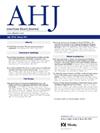非肥胖与肥胖合并银屑病关节炎和2型糖尿病患者的心律失常风险
IF 3.5
2区 医学
Q1 CARDIAC & CARDIOVASCULAR SYSTEMS
引用次数: 0
摘要
背景银屑病关节炎(PsA)和2型糖尿病(T2DM)均与心血管风险增加相关,但在这一人群中,体重指数(BMI)对心律失常的影响尚不清楚。本研究探讨了PsA和T2DM患者的BMI状况与心律失常风险之间的关系。方法利用TriNetX全球联邦健康研究网络访问100家医疗机构的电子病历,我们进行了一项回顾性队列研究。在倾向评分匹配后,我们比较了两组PsA和T2DM患者:非肥胖(BMI <30 kg/m²;n= 9762)和肥胖(BMI 30-60 kg/m²;n= 9762)。在5年的随访期间,主要结局是各种心律失常,包括房颤、室性心动过速、室上性心动过速和病窦综合征。结果非肥胖合并PsA和T2DM患者的房颤发生率明显高于匹配的肥胖患者(10.8% vs 9.7%,风险差[RD]=1.1%, 95% CI 0.3-2.0%, p=0.009)。非肥胖组的室性心动过速(1.6% vs 1.3%, RD=0.3%, p=0.137)、室上性心动过速(1.8% vs 1.3%, RD=0.5%, p=0.001)和病态窦性综合征(1.1% vs 0.9%, RD=0.2%, p=0.196)的发生率也较高。Kaplan-Meier分析显示,非肥胖患者无心律失常生存率显著降低(log-rank检验心房颤动和室上性心动过速p<;0.05)。此外,非肥胖患者需要植入起搏器的可能性高出40.5%(风险比1.41,95% CI 1.18-1.86)。结论:与传统观点相反,患有PsA和T2DM的非肥胖患者比肥胖患者发生心律失常的风险更高。这表明高BMI在这一特定患者群体中具有潜在的保护作用,或者反映了潜在疾病病理生理学的差异。临床医生应该考虑对患有PsA和T2DM的非肥胖患者进行更积极的心律失常筛查和监测,无论他们的体重是否明显更健康。本文章由计算机程序翻译,如有差异,请以英文原文为准。
Arrhythmia Risk in Non-Obese versus Obese Patients with Psoriatic Arthritis and Type 2 Diabetes
Background
Both psoriatic arthritis (PsA) and type 2 diabetes mellitus (T2DM) are associated with increased cardiovascular risk, but the impact of body mass index (BMI) on cardiac arrhythmias in this population remains unclear. This study examines the relationship between BMI status and risk of cardiac arrhythmias in patients with both PsA and T2DM.
Methods
Using the TriNetX global federated health research network accessing electronic medical records across 100 healthcare organizations, we conducted a retrospective cohort study. After propensity score matching, we compared two cohorts of patients with PsA and T2DM: non-obese (BMI <30 kg/m²; n=9,762) and obese (BMI 30-60 kg/m²; n=9,762). The primary outcomes were various cardiac arrhythmias, including atrial fibrillation, ventricular tachycardia, supraventricular tachycardia, and sick sinus syndrome during a 5-year follow-up period.
Results
Non-obese patients with PsA and T2DM had significantly higher rates of atrial fibrillation (10.8% vs 9.7%, risk difference [RD]=1.1%, 95% CI 0.3-2.0%, p=0.009) compared to matched obese patients. The non-obese cohort also showed numerically higher rates of ventricular tachycardia (1.6% vs 1.3%, RD=0.3%, p=0.137), supraventricular tachycardia (1.8% vs 1.3%, RD=0.5%, p=0.001), and sick sinus syndrome (1.1% vs 0.9%, RD=0.2%, p=0.196). Kaplan-Meier analysis demonstrated significantly lower arrhythmia-free survival for non-obese patients (log-rank test p<0.05 for atrial fibrillation and supraventricular tachycardia). Additionally, non-obese patients had a 40.5% higher likelihood of requiring pacemaker implantation (hazard ratio 1.41, 95% CI 1.18-1.86).
Conclusions
Contrary to conventional wisdom, non-obese patients with concurrent PsA and T2DM demonstrated higher risk of cardiac arrhythmias compared to their obese counterparts. This suggests a potential protective effect of higher BMI in this specific patient population or reflects differences in underlying disease pathophysiology. Clinicians should consider more aggressive arrhythmia screening and monitoring in non-obese patients with PsA and T2DM, regardless of their apparently healthier weight profile.
求助全文
通过发布文献求助,成功后即可免费获取论文全文。
去求助
来源期刊

American heart journal
医学-心血管系统
CiteScore
8.20
自引率
2.10%
发文量
214
审稿时长
38 days
期刊介绍:
The American Heart Journal will consider for publication suitable articles on topics pertaining to the broad discipline of cardiovascular disease. Our goal is to provide the reader primary investigation, scholarly review, and opinion concerning the practice of cardiovascular medicine. We especially encourage submission of 3 types of reports that are not frequently seen in cardiovascular journals: negative clinical studies, reports on study designs, and studies involving the organization of medical care. The Journal does not accept individual case reports or original articles involving bench laboratory or animal research.
 求助内容:
求助内容: 应助结果提醒方式:
应助结果提醒方式:


